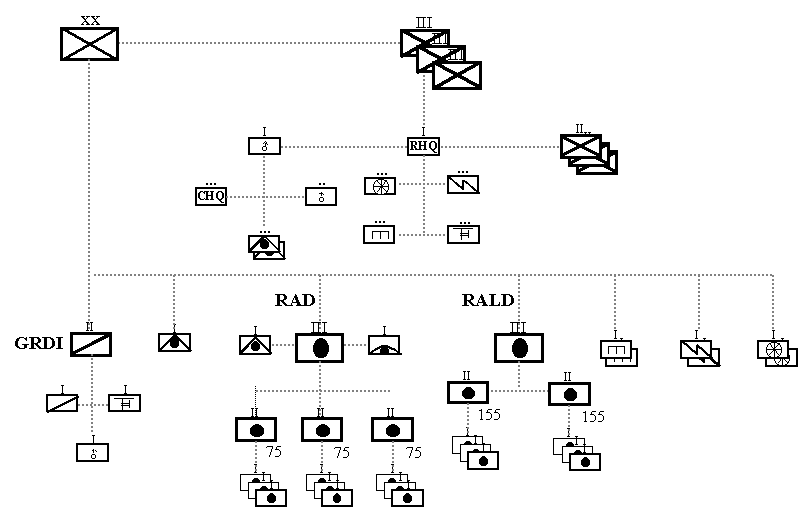

In 1940, the regular infantry division consisted of:
- 3 infantry regiments (each of a command company, a weapons company and
3 infantry battalions)
- 1 cavalry unit in charge of reconnaissance or GRDI (Groupe de Reconnaissance
de Division d'Infanterie)
- 1 AT company (12 25mm AT guns) usually attached to one of the infantry
regiment
- 1 light field artillery regiment with 3 groups of 12mm 75 guns each.
Also attached to this regiment, were 1 AT company (8 47mm AT guns) and
1 AA company (6 25mm AA guns) in charge of protecting the field guns from
ennemy tanks and planes
- 1 heavy field artillery regiment with 2 groups of 12 155mm howitzers
each
- 2 engineer companies
- 2 signal companies (1 radio and 1 telegraph)
- 2 transport companies (1 horse and 1 motorised)
- 1 ammunition company
- 1 medical group
- various services
Some type B Reserve Infantry Division had only one mixed artillery regiment with 4 groups of 12 75mm guns and 1 group of 12 155mm howitzers.
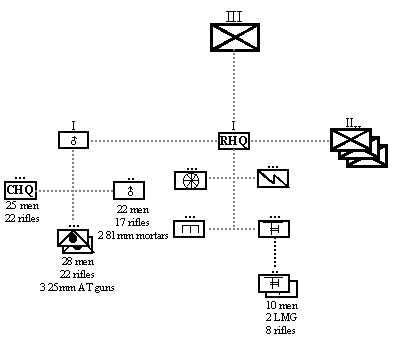
The infantry regiment consisted of:
- 1 headquarter with the
battalion commander, 3 officers, 1 sergeant, 1 secretary, 3 cyclists, 1
motocyclist and 1 car driver
- 1 command company with:
- 1 headquarter
- 1 services platoon
- 1 transmission platoon
- 1 combat engineer platoon
- 1 motocylists platoon with 1 command squad of 6 men and two combat squads
of 10 men with 2 LMGs each
- 1 supply company with
6 Renault U.E tracked vehicles
- 1 heavy weapon company
with
- 1 command platoon with the captain squad and 1 suppply squad
- 2 AT gun platoons with each 3 25 mm AT guns
- 1 mortar group with 2 81 mm mortars
- 3 infantry battalions
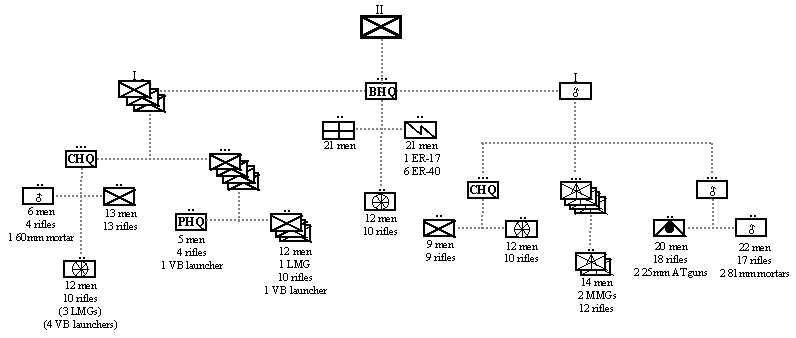
The regular infantry battalion consisted of:
- 1 headquarter with the
battalion commander, 3 officers, 1 sergeant, 1 secretary, 3 cyclists, 1
motocyclist and 1 car driver
- 1 command platoon with:
- 1 transmission squad with 1 ER17 radio for transmission with the regiment,
1 RII receptor for planes listening and 6 ER40 radios to be dispatched
in the various companies
- 1 medical squad with 1 doctor, 4 nurses and 16 stretcher-bearers
- 1 supply squad
- 3 infantry companies with
each:
- 1 command platoon with the captain squad, 1 supply squad with the spare
armament and 1 60 mm mortar squad
- 4 infantry platoons with each 1 command squad (1 commanding officer,
1 non-commissioned officer, 1 VB corporal in charge of rifle grenades action,
1 transmission agent and 1 observer) and 3 infantry squads (1 sergeant
and 11 men with 1 LMG, 1 VB launcher and 10 rifles)
- 1 heavy weapon company
with
- 1 command platoon with the captain squad and 1 suppply squad
- 4 MG platoons with each 2 MG squads (2 MMGs per squad)
- 1 heavy weapon platoon with 1 mortar squad (with 2 81 mm mortars) and
1 gun squad (with 2 25 mm AT guns)
Therefore, a regular infantry battalion had 36 LMGs, 48 VB rifle grenade launchers, 16 MMGs, 3 60mm mortars, 2 81mm mortars and 2 25mm AT guns.
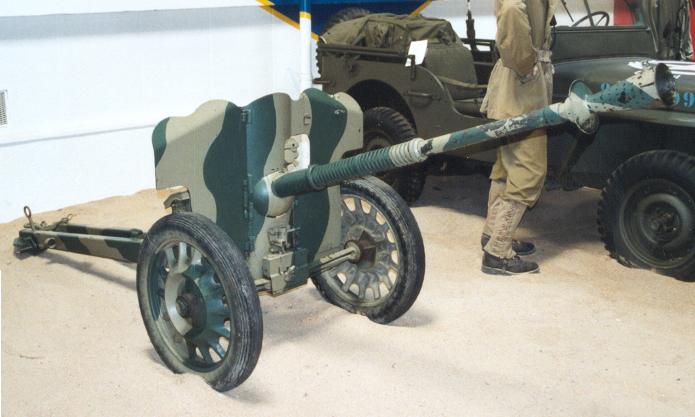
25mm SA light model 37 APX AT gun (Saumur
Tank Museum)
Infantry squad TOE
| Personnel | armament1 | ammunition1 | |
| 1 sergeant
squad leader |
1 rifle | 45 8mm cartridges
1 LMG magazine |
|
| Demi-groupe de fusiliers
(fire element) |
1 corporal | 1 rifle | 45 8mm cartridges
2 LMG magazines |
| 1 LMG gunner | 1 FM 24/29 LMG | 3 LMG magazines | |
| 1 LMG loader | 1 pistol | 3 LMG magazines
325 7.5mm cartridges |
|
| 1 ammo carrier | 1 carbine | 45 8mm cartridges
4 LMG magazines 150 7.5mm cartridges |
|
| 1 ammo carrier | 1 carbine | 45 8mm cartridges
4 LMG magazines 150 7.5mm cartridges |
|
| 1 ammo carrier | 1 carbine | 45 8mm cartridges
4 LMG magazines 150 7.5mm cartridges |
|
| Demi-groupe de voltigeurs
(shock element) |
1 first rifleman | 1 rifle | 90 8mm cartridges |
| 1 rifleman | 1 rifle | 90 8mm cartridges | |
| 1 rifleman | 1 rifle | 90 8mm cartridges | |
| 1 rifleman | 1 rifle | 90 8mm cartridges | |
| 1 rifle grenadier2 | 1 rifle and 1 VB launcher | 8 VB rifle grenades |
1
Most infnatry squads were still equipped with WWI rifles (07/15 and 07/15
M16 rifles). These older weapons still used the 8mm cartridges which required
the infantry squad to carry two calibres of ammunition (7.5mm for the FM24/29
LMG and 8mm for the rifles and carbines). The 7.5mm rifle (MAS 36) was
starting to be distributed among infantry units (only 250 000 MAS 36 rifles
were handled by the Army by June, 23rd, 1940)
2
The rifle grenadier was still equipped with the Lebel 1886/93 rifle which
could sustain rifle grenade firing (the 07/15 rifle was too fragile for
such a use). Note that the MAS 36 rifle could also sustain rifle grenade
firing. The rifle grenadier was dispatched at the platoon level under the
command of the VB corporal in charge of rifle grenades action.
The GRDI was the only cavalry unit in the Infantry Division and consisted of 3 squadrons:
- 1 cavalry squadron with 1 command platoon, 4 combat platoons, 1 MG platoon and 1 AT group. Each combat platoon had 35 men: one command squad of 5 men, 2 combat squads and 1 riflemen sub-squad. Each combat squad had 2 sub-squads of 6 men each: 1 riflemen sub-squad and 1 LMG sub-squad. Therefore, the cavalry squadron had only 8 LMGs. The MG platoon had 4 MMGs. The AT group consisted of 2 25mm AT guns (this was not realized in all GRDI). In addition, the command platoon had 1 60mm mortar.
- 1 squadron of motocyclists with 4 combat platoons. Each combat platoon had a command squad of 6 men and two combat squads of 10 men with 2 LMGs each, transported by 13 side-cars (one for two men). In addition to the 4 combat platoons, the squadron had 1 60mm mortar (4-men crew on 2 side-cars) and a command platoon of 30 to 40 men with a few vehicules (2 trucks, 4 pick-up and 2 cars).
- 1 squadron of Mitrailleuses et Engins (support company) with 2 MG platoons and two anti-tank groups. The MG platoon has 4 MMGs. The anti-tank group had 2 25mm AT gun (8-men crew). Note that one of 25mm AT guns was usually replace by a 37mm Infantry gun.
Therefore, a GRDI had 24 LMGs, 12 MMGs, 2 60mm mortars and 3 to 6 25mm AT guns.
In 1940, the infantry platoon was about to receive 50mm grenade launcher instead of its VB rifle grenade launchers. Although 20 000 50mm grenade launchers had been built by June 1940, this weapon was not yet distributed to the infantry since less than 100 000 rounds were available. Also, the infnatry units had not been trained to use this new weapon which was supposed to be distributed in september 1940.
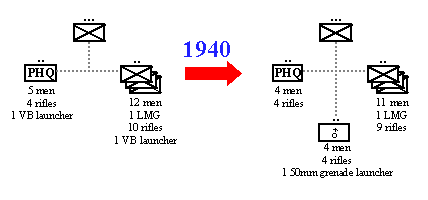
The new infantry platoon should have consisted of:
- 1 command squad (1 commanding
officer, 1 non-commissioned officer, 1 transmission agent and 1 observer)
- 3 infantry squads (1 sergeant
and 10 men with 1 LMG and 9 rifles each)
- 1 50mm grenade launcher
squad (1 corporal and 3 men with 1 50mm grenade launcher)
Back to Homepage